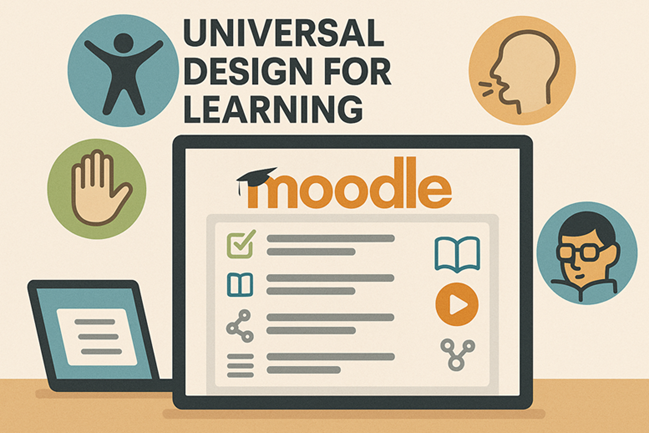This month we continue our Universal Design for Learning series by taking a look at how you can use three Moodle activities.
Universal Design for Learning (UDL) is an educational framework that aims to make learning accessible, inclusive, and challenging for all learners. To do this, UDL encourages you to offer multiple ways of:
- Engagement – motivating and involving students in different ways.
- Representation – presenting information in various formats (e.g., visual, auditory, text).
- Action and Expression – allowing students to demonstrate what they know in different ways.
Engagement
One example of using UDL to increase student engagement is through the use of the Glossary activity within Moodle.
Glossaries are a good way of explaining key terms to students, and are particularly useful for students new to the subject area or whose first language isn’t English.
They can be used in two ways in Moodle, the first is where you as the lecturer provide the explanation of key terms for students.
The second, which ties in with the Engagement principle, is to create a Glossary where students are encouraged to contribute their own entries, and to work together to add key terms that they feel are important. This shifts students from being passive recipients of your knowledge to being active participants in the learning process.
For example, in a photography course, the lecturer could create a Glossary called “Key Photography Terms”, and then assign each student a term to define and explain in their own words, which is then added to the page. Glossaries can allow students to add text, links, audio, and video content. Students are then learning from each other, and are more likely to engage with the activity if it’s something that they have created.

Representation
H5P allows you to easily create interactive media that combines text, images, audio, video and interactive elements in a way that can cater to diverse learning styles.
There are dozens of H5P activities that could be used in context with your subject area, but some example of use are:
- To annotate an image with hotspots that provide explanation to what is being displayed. For example, showing the structure of a piece of code, or a detailed explanation of what the buttons are on a piece of equipment.

- Short videos could be created, that have quizzes embedded as knowledge checks for the students.

- Create a branching scenario in which a student has to choose the correct path through a process, with feedback given for incorrect choices. An example could be a mock interview where certain questions are more favourable than others. An example of how a branching scenario has been used by another institute can be found on the H5P website.
Action & Expression
The Action & Expression principle of UDL emphasizes giving students multiple ways to demonstrate their knowledge.
The Forum activity (also displayed as Announcements on Moodle), is a simple way of encouraging discussion amongst students.
For example, in a unit in which we discuss theories and ideas, a Forum can be set up where students are asked to share their research around the topic and for them to then provide peer feedback on ideas that others have shared.

Getting started
If you’d like to try anything mentioned above, please feel free to get in contact with the Digital Learning Team (LCCDigitalLearning@lcc.arts.ac.uk). We are always happy to discuss ideas and provide support. If something you have tried works, let us know!

